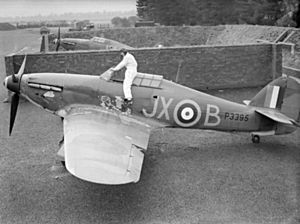Arthur Clowes facts for kids
Quick facts for kids
Arthur Clowes
|
|
|---|---|

Portrait of Clowes, made by Cuthbert Orde in February 1941
|
|
| Nickname(s) | 'Taffy' |
| Born | 16 August 1912 Sawley, Derbyshire, United Kingdom |
| Died | 7 December 1949 (aged 37) Ely, Cambridgeshire, United Kingdom |
| Buried |
Brampton, Cambridgeshire, United Kingdom
|
| Allegiance | United Kingdom |
| Service/ |
Royal Air Force |
| Years of service | 1929–1949 |
| Rank | Squadron Leader |
| Unit | No. 1 Squadron |
| Commands held | No. 94 Squadron No. 601 Squadron No. 79 Squadron |
| Battles/wars | Second World War |
| Awards | Distinguished Flying Cross Distinguished Flying Medal Mention in Despatches |
Arthur Clowes, nicknamed 'Taffy', was a brave British pilot who served in the Royal Air Force (RAF) during the Second World War. Born on 16 August 1912, he became known as a "flying ace" because he shot down at least ten enemy aircraft.
Clowes joined the RAF in 1929, first working on ground crew. He then trained to become a pilot. When the Second World War began, he was a sergeant pilot with No. 1 Squadron. He flew many missions during the Battle of France and the Battle of Britain. During these battles, he achieved several victories and became an officer. After teaching other pilots for a while, he led different fighter squadrons. His flying career ended in 1943 after an accident caused him to lose sight in one eye. He continued to work for the RAF in an office role until he sadly passed away in 1949 at the age of 37.
Contents
Becoming an RAF Pilot
Arthur Victor Clowes was born in Sawley, Derbyshire, on 16 August 1912. His father fought in the First World War and died in 1917. Arthur went to Long Eaton Council Elementary School. In early 1929, he joined the Royal Air Force (RAF) to work as ground crew. He became a skilled metal rigger by late 1931.
Arthur then decided he wanted to fly. He volunteered for pilot training and earned his pilot's "wings." After this, he joined No. 1 Squadron as a sergeant pilot. At that time, No. 1 Squadron was based at RAF Tangmere and flew Hawker Fury fighter planes. In 1938, the squadron started using the newer Hawker Hurricane fighter.
Fighting in the Second World War
In September 1939, No. 1 Squadron moved to France to help with the war effort. They were based at Vassincourt and patrolled the border between France and Germany. They sometimes fought against the German air force, called the Luftwaffe.
On 23 November, Clowes, known as 'Taffy', was flying with two other Hurricanes. They chased a German Heinkel He 111 bomber. Clowes shot it down! Right after, a French fighter plane accidentally crashed into his Hurricane, damaging its tail. Luckily, Clowes managed to crash-land safely back at his airfield.
On 29 March 1940, while patrolling near Metz, Clowes's group spotted some Messerschmitt Bf 110 heavy fighters. Clowes destroyed two of them, and his teammates claimed the third. This was the first time RAF pilots had shot down a Bf 110. The commander of RAF forces in France, Air Marshal Arthur Barratt, even took them to dinner in Paris to celebrate! Clowes was soon promoted to flight sergeant.
The Battle of France
When Germany invaded France on 10 May, No. 1 Squadron was immediately in heavy action. Clowes was on leave in England but quickly returned to his unit. He immediately joined the fight. On 14 May, he destroyed a Messerschmitt Bf 109 fighter and a Junkers Ju 87 dive bomber.
On 23 May, he helped shoot down a He 111 near Rouen, though this couldn't be fully confirmed. As the German forces advanced, the squadron had to keep moving to different airfields. On 14 June, Clowes destroyed another Bf 109. Later that month, the squadron left France and regrouped back in England at Tangmere. Clowes was praised for his bravery on 11 July.
The Battle of Britain
No. 1 Squadron returned to active duty in late July, moving to RAF Northolt. On 16 August, Clowes shot down two German bombers, a He 111 and a Junkers Ju 88, over the South Downs. A few days later, he received the Distinguished Flying Medal for his bravery in France. The award citation said he showed "courage and determination" and had destroyed "at least six enemy aircraft."
On 30 August, Clowes damaged a Bf 110 and a He 111. The next day, he likely destroyed two Dornier Do 17 bombers and another Bf 110. On 7 September, he shot down a Bf 110 over the Thames estuary. Soon after, No. 1 Squadron moved north to RAF Wittering for a much-needed break. Clowes was then made an officer, becoming a pilot officer. On 24 October, he helped shoot down a Do 17. By this time, he was one of the squadron's flight commanders, leading groups of planes.
Later War Service
In early 1941, No. 1 Squadron returned to southern England. They flew from RAF Kenley, escorting bombers and attacking targets in France. Clowes led one of the squadron's first missions, attacking German buildings near Calais. He was promoted to flying officer on 3 February.
Two months later, he was sent to teach new pilots at training units. By this time, he had also received the Distinguished Flying Cross. The award citation praised his "great skill" and said he had destroyed "at least 11 of their aircraft." It also noted his "coolness and judgment" which inspired other pilots.
On 10 December, Clowes was promoted to flight lieutenant and given command of No. 79 Squadron. This unit, based in Coventry, flew Hurricanes on patrol and intercepted German bombers. In February 1942, the squadron went to the Far East, but Clowes was sent to the Middle East.
From August 1942 to March 1943, he commanded No. 601 Squadron in Egypt. They flew Supermarine Spitfire fighters, supporting ground troops. In June, he took command of No. 94 Squadron in Libya. They flew Hurricanes and Spitfires on missions to Crete and the Aegean Sea. His time leading squadrons and his flying career ended in September 1943. He was injured and permanently lost sight in one eye.
After the War
In September 1945, Clowes moved to an administrative role in the RAF as a squadron leader. He later attended the RAF Staff College. Sadly, he developed liver cancer and was hospitalized at RAF Hospital Ely. He passed away there on 7 December 1949, at the age of 37. He was buried in Brampton.
Arthur Clowes is officially credited with shooting down ten enemy aircraft. He also likely destroyed three more and damaged two others.
Images for kids




